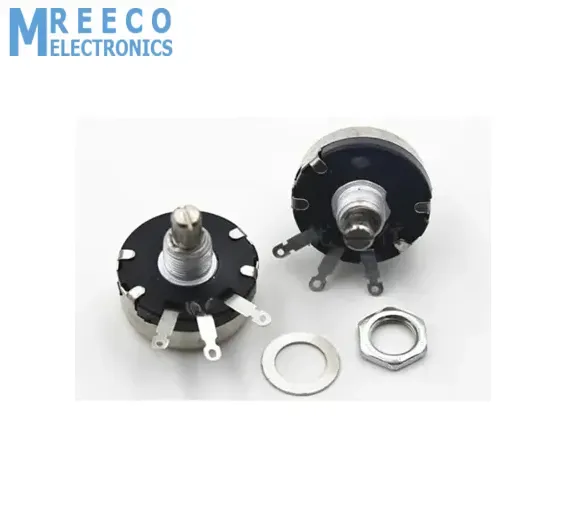1K 1W Single Turn Rotary Taper Carbon Wire wound Potentiometer Volume Resistor
SKU: 637725000601163425
A variable resistor is the most significant component found in many electrical devices for controlling the tone, bass as well as volume. This is due to the fact that resistors can be connected together with the other components to form filters for the desired level. They can also be used in computer monitors for color or positioning as well as dimming or switching lamps. This is achieved through digital to analog and analog to digital circuits; one additional advantage is that the knob can be turned instead of typing a value every time you want to change the tint or brightness.
Types of variable Resistors
A variable resistor is a resistor in which the electric resistance value is adjustable. A variable resistor is an electro-mechanical transducer that generally works by sliding a contact (wiper) over a resistive element. A variable resistor is used because a potential divider with 3 terminals is known as a potentiometer. When it has two terminals, it acts as a variable resistor, which is known as a
Rheostat
. An electronically controlled variable resistor controls electronically instead of using a mechanical action. This resistor is called as a digital potentiometer.Types of Variable Resistors
Potentiometer
A potentiometer is an ordinary variable resistor. It functions as a potential divider, which is used to generate a voltage signal depending on the location of the potentiometer. This is the signal that can be used for a very wide variety of applications including an amplifier gain control, measurement of the distance or angles, tuning of the circuits and much more. Whenever variable resistors are used to tune or calibrate a circuit or its application or trimmer potentiometers or trim potsare used, these are generally less rated potentiometers which are mounted on the circuit board and are adjustable by using a screwdriver.
Potentiometer
ResistorRheostat
Rheostat
s are much related to the potentiometers in terms of construction, but they are not used as a potential divider, instead, they are used as variable resistors. They can use only 2 terminals rather than 3 terminals’ potentiometers. One connection is connected at one end of the resistive element, the other is at the wiper of the variable resistor. In the ancient times, rheostats were used as the power control devices, which were connected in series with the load, just like a bulb. At present rheostats are not used as power controller any longer as it is an inefficient method. For the power control, rheostats are replaced in high-efficieny switching electronics. At preset variable resistors are wired as the rheostats, which are used in circuits to perform the tuning or calibration.Rheostat
ResistorDigital Resistor
A digital variable resistor is a type of variable resistor that is used whenever the change of resistance is not performed by the mechanical movement, but by the electronic signals. They can also change resistance in discrete steps and are frequently controlled by the digital protocols such as I2C or by simple up and down signals.
Digital Resistor
Presets
Presets
are just like the small version of a variable resistor. They can be placed easily on a PCB and can also be adjustable when needed. The value of the resistance is normally adjusted with the help of a screwdriver. They are frequently used in applications that have adjustable frequency tone of the alarm or adjustable sensitivity circuits. These are the cheapest among the devices that are mentioned above. These are also highly specific presets that have multi-turn options. In this type of presets, the resistances are increased or decreased gradually and therefore the screw has to be rotated the numberof times.Presets
ResistorVariable Resistor Connection
A Variable Resistor is used as a rheostat when one end of the resistance is tracked and the wiper terminal is connected to the circuit and the other terminal of the resistance track remains open. In this case, the electrical resistance is connected between the track terminal and wiper terminal which depends upon the position of the wiper (slider) on the resistances track. A variable resistor can also be used as a potentiometer when both ends of the resistance track are connected to the input circuit and one of the said ends of resistance track and wiper terminal is connected to the output circuit.
Variable Resistor Connection
In this case, all three terminals are in use. Sometimes, in electronics circuit, there may be a requirement of adaptable resistance, but this modification is required only once or very often. This is done by connecting preset resistors in the circuit. The preset resistor is one kind of variable resistor whose electrical resistance value can be adjusted by adjusting an adjustable screw attached to it.
Working principle of Variable Resistor
As shown in the figure below, a variable resistor consists of a track that provides the resistance path. The two terminals of the machine are connected to both the ends of the track. The third terminal is associated to a wiper that decides the movement of the track. The motion of the wiper throughout the track helps in increasing and decreasing the resistance.
The track is generally made of a mixture of ceramic and metal or can be made of the carbon as well. As the resistive material is required, a carbon film type of variable resistors is generally used. They find applications in the radio receiver circuits, audio amplifier circuits, and TV receivers. The rotary track resistor has two applications: one is to modify the resistance and the other – the switch method – which is is used for the electric contact and non-contact by the on/off operation of the switch. There is a switch method in which variable resistors with the annular cross-section are used for controlling the equipment. The track made in a straight path is called a slider. As the position of the slider cannot be seen or confirmed according to the modification of resistance, a stopping mechanism is generally integrated to prevent the hazards caused due to over rotation.
Uses of Variable Resistors
A Variable Resistor can be used mostly in two different ways. When one end of the resistance track and wiper terminal is connected with the circuit, the current through the resistor limits according to the position of the wiper contact on the resistance track. As the wiper contact slides away from the connected end of the resistance track, the resistive value of the resistor increases and current goes down through the circuit-which means, the variable resistor behaves like a rheostat.
Another use is as a potentiometer. In this case, the two ends of the resistance track are connected to a voltage source. Hence, the voltage drop across the resistance track is equal to the value of the voltage sources. Now the output or load circuit is connected to one end of the resistance track and wiped terminal. Hence, the voltage across the load terminals is the fraction of the source voltage and it depends upon the position of the wiper terminals on the resistance track. This is another widely used application of variable resistors.
Potentiometer
s are used to control voltages, whereas rheostats are used to control electric currents.Applications of Variable Resistors
Variable Resistors can be found in
- Audio control
- Television
- Motion control
- Transducers
- Computation
- Home Electrical Appliances
- Oscillators
Future Electronics has a complete selection of variable resistors of different sizes from several manufacturers when looking for a variable resistor chip, variable resistor potentiometer, 12-volt variable resistor, digital variable resistor, high power variable resistor or trimmer resistor. Simply choose from the variable resistor’s technical attributes below and your search results will quickly be narrowed in order to match your specific variable resistor’s application needs.
Thus, this is all about types of variable resistors, it’s working, and applications. We hope that you have got a better understanding of this information. Furthermore, any queries regarding this concept or electrical and electronics projects, please give your valuable suggestions by commenting in the comment section below. Here is a question for you, what is the function of variable resistor?


